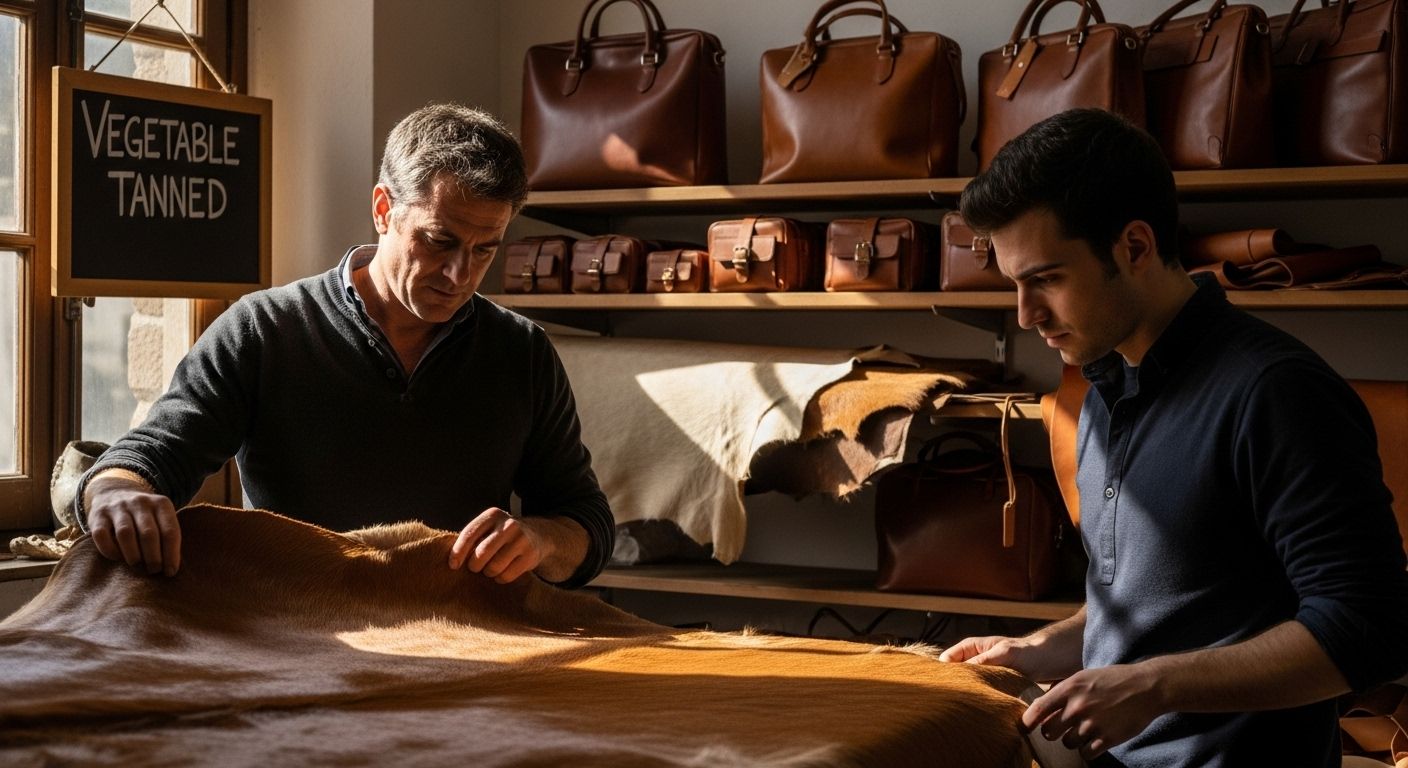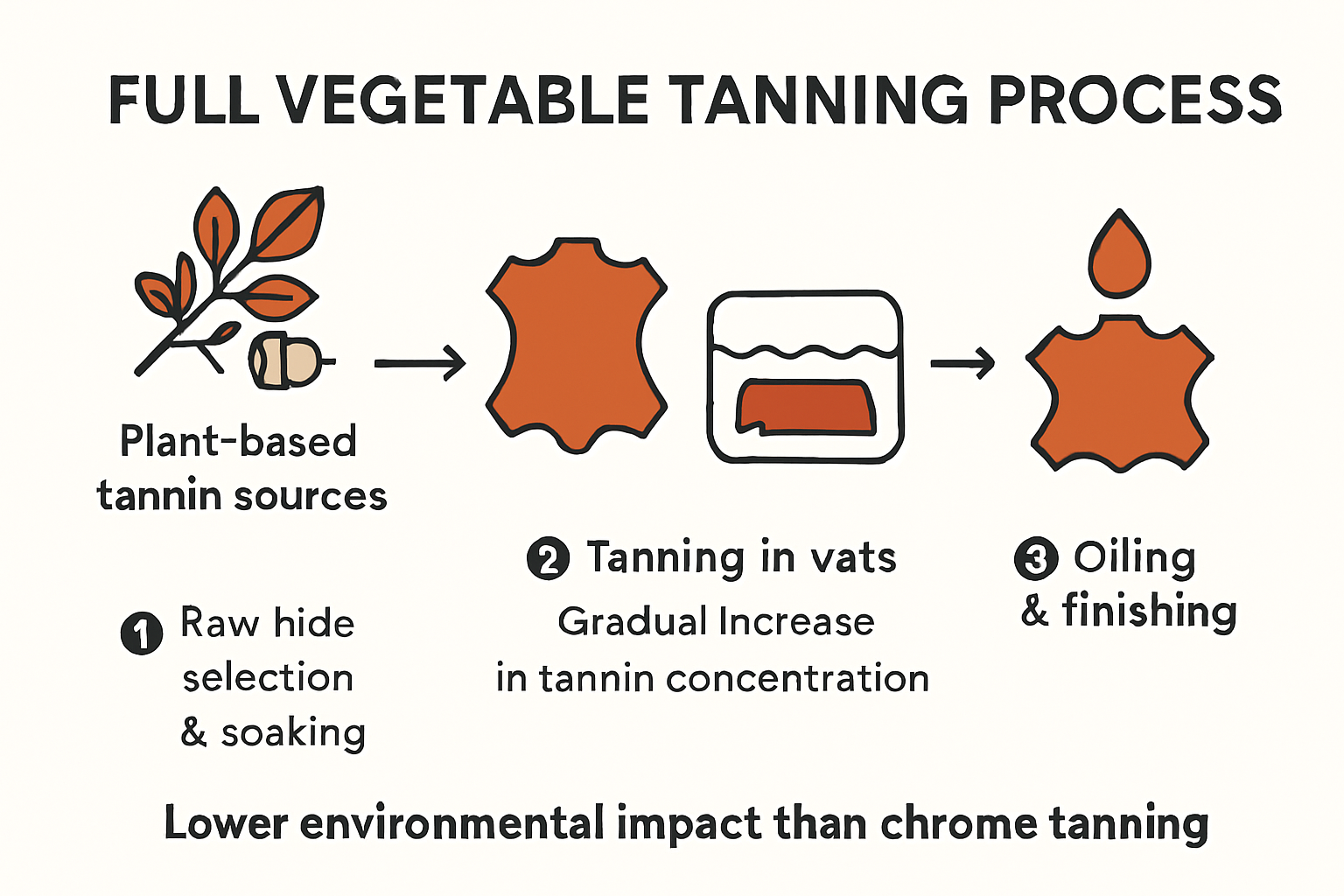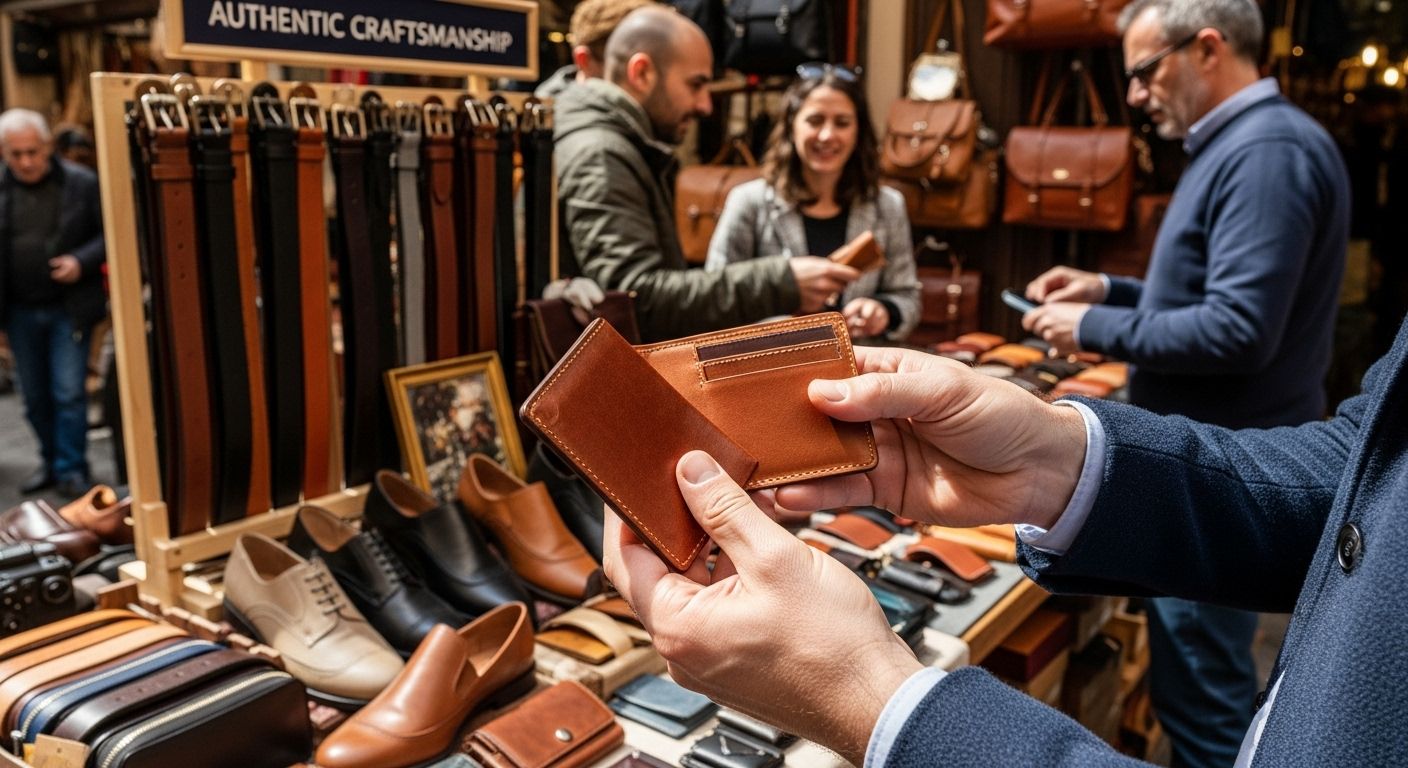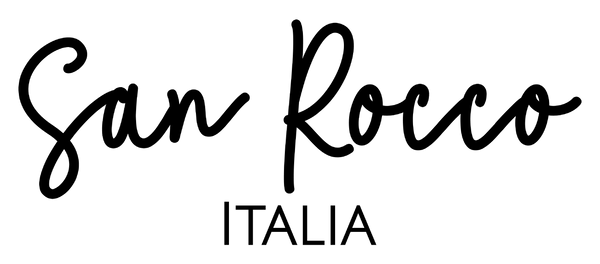
What Is Vegetable Tanned Leather? The Italian Craft Unveiled
Share

Vegetable tanned leather sounds like a throwback to the slow, careful days of craft, where natural ingredients mattered more than speed. Yet, believe it or not, this traditional method still shapes some of the world’s most luxurious accessories with surprises at every turn. While most leather you see is treated with chemicals, only about 10 percent of global leather is vegetable tanned, making every genuine Italian piece an exclusive slice of living history that ages beautifully with you.
Table of Contents
- Understanding Vegetable Tanned Leather Process
- Why Italian Vegetable Tanned Leather Stands Out
- Benefits for Quality and Sustainable Fashion
- Choosing Authentic Pieces for Timeless Style
Quick Summary
| Takeaway | Explanation |
|---|---|
| Vegetable tanning uses natural plant sources. | The process employs tannins from trees, creating leather without harmful chemicals. |
| Italian leather is known for superior craftsmanship. | This leather showcases generations of artisanal skills, ensuring exceptional quality and durability. |
| Authentic leather develops a unique patina. | Over time, it gains character and depth of colour, enhancing its aesthetic appeal. |
| Choose pieces crafted ethically for sustainability. | Opt for well-made items that align with responsible consumption and support traditional techniques. |
| Invest in timeless style over fast fashion. | Authentic leather pieces age beautifully and become lasting, personal artifacts rather than disposable trends. |
Understanding Vegetable Tanned Leather Process
Vegetable tanned leather represents a time-honoured craft that transforms raw animal hides into supple, durable material through an intricate and patient process rooted in centuries of artisanal tradition. Unlike modern chemical tanning methods, this technique relies on natural plant-based tannins to create leather with exceptional character and longevity.
The Natural Tanning Foundations
The vegetable tanning process begins with carefully selected animal hides that undergo a meticulous transformation. According to Research in Conservation Science, this method can take up to two years to complete, reflecting the extraordinary patience and skill required by master craftsmen. Tannins, the key agents in this process, are extracted from various plant sources including chestnut, oak, and hemlock trees, creating a natural chemical reaction that stabilises the leather’s protein structure.
Traditional tanneries hang hides on large frames inside expansive vats, systematically exposing them to increasingly concentrated tannin solutions. Environmental Science Research reveals that hides are methodically transferred between different bins, each containing a progressively stronger tannin concentration. This gradual approach ensures complete and uniform penetration of the tanning agents throughout the leather’s structure.
Complex Chemical Transformation
The vegetable tanning process is far more than a simple treatment. The polyphenols contained in plant tannins interact with the hide’s proteins, creating a complex chemical transformation. As detailed in Leather Chemistry Journal, these natural compounds are found in multiple plant parts including wood, bark, leaves, roots, and fruits. The interaction between these tannins and the hide’s molecular structure produces leather with remarkable qualities.

What distinguishes vegetable tanned leather is its ability to develop a unique patina over time. Unlike synthetically tanned leathers that remain static, vegetable tanned leather ages gracefully, acquiring depth of colour and character with each use. The natural colour ranges from pale brown to rich reddish-brown, depending on the specific tannins employed in the process.
The final stages involve carefully applying oils and lubricants to enhance the leather’s flexibility and prepare it for crafting into exquisite products. Skilled artisans ensure that each piece maintains its structural integrity while becoming increasingly supple and responsive to its environment. This meticulous approach transforms a raw hide into a material that tells a story of craftsmanship, patience, and respect for natural processes.
Why Italian Vegetable Tanned Leather Stands Out
Italian vegetable tanned leather represents the pinnacle of craftsmanship, embodying a rich heritage of artisanal excellence that has been carefully preserved and refined over generations. This exceptional material distinguishes itself through a combination of historical expertise, innovative techniques, and an unwavering commitment to quality that sets it apart in the global leather industry.
Heritage of Mastery
The reputation of Italian vegetable tanned leather extends far beyond mere production. According to PubMed Research, leather represents a fully biobased and biodegradable material with collagen as its primary constituent. Italian artisans have transformed this understanding into an art form, developing techniques that not only preserve the natural properties of leather but also elevate its aesthetic and functional qualities.
The Tuscan leather district has become synonymous with exceptional leather craftsmanship, where generational knowledge combines with modern innovation. Each hide tells a story of meticulous care, from selection to final treatment, ensuring that every piece meets the highest standards of quality and durability.
Design and Technical Innovation
Rhode Island School of Design’s Leather Craft Program highlights the remarkable versatility of Italian vegetable tanned leather. The material offers extraordinary adaptability, allowing artisans to employ techniques like wet-molding, precise etching, and intricate shaping. This flexibility transforms leather from a mere material into a medium of artistic expression.
The educational initiatives exploring Italian leather craftsmanship reveal a profound understanding of the material’s potential. Through immersive programs and tannery visits, designers and craftspeople learn how Italian leather represents more than a product - it embodies a sophisticated approach to material design that respects both traditional techniques and contemporary innovation.
Sustainable Luxury
What truly distinguishes Italian vegetable tanned leather is its commitment to sustainability and ethical production. Unlike mass-produced alternatives, these leathers are created through environmentally conscious processes that prioritize natural ingredients and minimal chemical intervention. The result is a material that not only looks and feels exceptional but also aligns with modern values of responsible manufacturing.
The leather’s ability to develop a unique patina over time further enhances its appeal. Each piece becomes a personal artifact, telling the story of its journey and the moments it has witnessed. This characteristic transforms vegetable tanned leather from a mere material into a living, evolving companion that gains character and beauty with each use.
Italian vegetable tanned leather stands as a testament to the power of combining traditional craftsmanship with innovative design. It represents a holistic approach to material creation that respects historical techniques while embracing contemporary needs for sustainability, quality, and aesthetic excellence.
Benefits for Quality and Sustainable Fashion
Vegetable tanned leather represents a profound intersection of quality craftsmanship and sustainable fashion, offering discerning consumers an environmentally conscious alternative that does not compromise on aesthetic appeal or durability. This exceptional material transcends traditional leather production methods by prioritising natural processes and ecological responsibility.
Environmental Consciousness
Traditional leather production often involves harmful chemical processes, but vegetable tanned leather offers a transformative approach. According to Sustainable Materials Research, this method uses natural tannins extracted from plant materials like chestnut wood and oak bark, effectively avoiding toxic chemical treatments. Ecological integrity becomes a core feature of the leather’s production, making it an ideal choice for environmentally aware consumers.
Here is a comparison table that highlights the main differences between vegetable tanned leather and chemically tanned leather, summarising distinctions that are referred to throughout the article.
| Feature | Vegetable Tanned Leather | Chemically Tanned Leather |
|---|---|---|
| Tanning agents | Natural plant tannins (e.g. chestnut, oak) | Synthetic chemicals (e.g. chromium III) |
| Environmental impact | Eco-friendly, minimal chemicals | Often involves toxic waste |
| Time required for tanning | Up to two years | A few days or weeks |
| Aesthetic qualities | Ages with patina, natural variations | Colour remains static |
| Flexibility & Breathability | Increases with use, adapts to wearer | Remains largely unchanged |
| Rarity (global production share) | About 10% | About 90% |
| Biodegradability | Biobased, biodegradable | Less biodegradable |
Zero Waste Sustainable Footwear Guidelines highlight that vegetable tanned leather is created using plant-based tanning agents such as gall nuts, quebracho wood, and mimosa trees. By eliminating chromium III and other toxic chemicals typically used in leather production, this method significantly reduces environmental impact while maintaining exceptional material quality.
Aesthetic and Functional Excellence
Beyond its ecological benefits, vegetable tanned leather offers remarkable aesthetic qualities. The natural tanning process produces leather with rich, warm tones that develop a unique personal patina over time. Unlike synthetic alternatives that remain static, vegetable tanned leather evolves, telling a story through its changing colour and texture. Each piece becomes a personalised artifact that reflects its journey and the individual experiences of its owner.
The material’s breathability and natural flexibility distinguish it from chemically treated leathers. Its ability to adapt to body temperature and movement makes it particularly suitable for high-quality fashion accessories and clothing. The leather becomes more comfortable and responsive with use, creating a symbiotic relationship between the wearer and the material.
Ethical Fashion and Longevity
Vegetable tanned leather embodies the principles of slow fashion, challenging the disposable culture prevalent in contemporary clothing industries. By producing a material that improves with age and maintains structural integrity, artisans create products designed for longevity rather than rapid consumption. This approach represents a fundamental shift in fashion philosophy, prioritising quality, sustainability, and timeless design.
Consumers choosing vegetable tanned leather invest not just in a product, but in a sustainable lifecycle. The leather’s durability means fewer replacements, reduced waste, and a lower overall environmental footprint. Each piece becomes a statement of personal values, reflecting a commitment to responsible consumption and appreciation for traditional craftsmanship.
In an era of increasing environmental consciousness, vegetable tanned leather emerges as a compelling solution that harmonises aesthetic excellence, functional performance, and ecological responsibility. It represents more than a material choice - it is a philosophy of mindful, sustainable living expressed through exceptional craftsmanship.
Choosing Authentic Pieces for Timeless Style
Selecting authentic vegetable tanned leather pieces requires a discerning eye and understanding of craftsmanship that transcends mere aesthetic appeal. This material represents an investment in quality, style, and sustainable fashion that rewards the careful consumer with products that age beautifully and tell a unique story.
Identifying Genuine Craftsmanship
Best Leather Research reveals that authentic vegetable tanned leather is characterised by its distinctive qualities. Initially stiff, these pieces become increasingly supple with use, developing a rich patina that reflects their journey. Authentic pieces will showcase visible natural fibers, presenting earthy tones ranging from deep browns to warm beiges, yellows, and reds.
The production of these pieces is intentionally time-consuming, which directly impacts their value. Unlike mass-produced alternatives, vegetable tanned leather items are crafted through meticulous processes that can take months. According to Wikipedia’s Leather Tanning Overview, this traditional method binds natural tannins to collagen proteins, creating leather that is both flexible and remarkably durable.
Understanding Material Characteristics
Discerning consumers should look for specific indicators of quality. Genuine vegetable tanned leather will have natural variations in color and texture, with each piece telling its own unique story. The material should feel substantial yet malleable, with a softness that increases over time. Products like luggage, belts, footwear, and accessories crafted from this leather represent more than mere purchases - they are investments in timeless style.
However, Collective Fashion Justice Research provides an important perspective, noting that while vegetable tanned leather is often marketed as highly sustainable, the environmental differences between tanning methods may be less significant than perceived. Approximately 90% of leather is chrome-tanned, making vegetable tanned pieces relatively rare.
Making Conscious Style Choices
Choosing vegetable tanned leather is about more than following a trend - it’s about embracing a philosophy of mindful consumption. These pieces represent a commitment to craftsmanship, supporting artisanal techniques that have been refined over generations. When selecting an item, consider its potential longevity, the story behind its creation, and how it will develop character over time.
Look for craftsmen who transparently share their production processes, who value traditional techniques, and who prioritise quality over quantity. The perfect piece should not only complement your personal style but also reflect your values of sustainability and appreciation for exceptional craftsmanship.
In a world of fast fashion and disposable accessories, vegetable tanned leather stands as a testament to timeless elegance. Each piece is more than an accessory - it is a personal artifact that grows more beautiful with every experience, every journey, and every moment of wear.

Frequently Asked Questions
What is vegetable tanned leather?
Vegetable tanned leather is a type of leather treated using natural plant-based tannins rather than synthetic chemicals. This traditional method creates leather that is durable, eco-friendly, and develops a unique patina over time.
How long does the vegetable tanning process take?
The vegetable tanning process can take up to two years. This lengthy period allows for a meticulous transformation of raw animal hides into supple, high-quality leather through exposure to concentrated tannin solutions.
What are the benefits of choosing vegetable tanned leather?
Vegetable tanned leather is environmentally conscious, biodegradable, and does not involve harmful chemicals. Additionally, it offers aesthetic qualities that improve with age, making it a long-lasting, sustainable choice for fashion items and accessories.
How can I identify authentic vegetable tanned leather?
Authentic vegetable tanned leather is characterised by natural variations in colour and texture, a substantial yet malleable feel, and visible natural fibres. Over time, it develops a rich patina, reflecting its unique journey and quality craftsmanship.
Experience Authentic Italian Vegetable Tanned Leather at San Rocco Italia
If you crave the warmth and character of genuine vegetable tanned leather yet struggle to find pieces that truly honour craftsmanship and legacy, San Rocco Italia bridges this gap for you. Many shoppers find themselves frustrated by mass-produced, chemically-treated leather that lacks the individual story, environmental responsibility, and durability described in the article. Are you searching for a handbag or accessory that develops a unique patina, lasts for years, and supports traditional Italian artisanship? Our commitment to timeless design and full-grain, vegetable tanned leather ensures each piece carries the Italian heritage detailed above, bringing quality and elegance to your daily life. Discover the difference that real craftsmanship makes, with the peace of mind that comes from ethical and sustainable sourcing.

Explore our luxury handbags and leather goods crafted by skilled artisans in Italy. You deserve accessories that age beautifully, tell a story, and reflect your values. Visit San Rocco Italia now to find your own authentic Italian masterpiece and embrace conscious style today.


